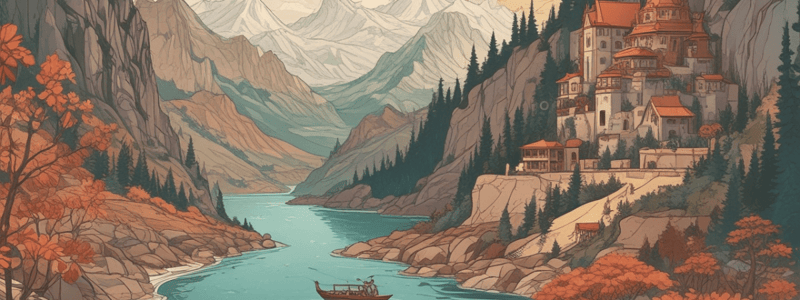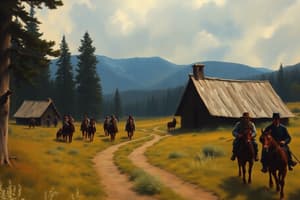Podcast
Questions and Answers
What was the biggest killer on the Oregon Trail?
What was the biggest killer on the Oregon Trail?
- Accidents
- Drownings at river crossings
- Gunshot wounds
- Disease (correct)
Approximately what percentage of emigrants on the Oregon Trail died from illness?
Approximately what percentage of emigrants on the Oregon Trail died from illness?
- 5%
- 20%
- 10% (correct)
- 15%
Where did the Oregon Trail typically end for those who stuck to the trail?
Where did the Oregon Trail typically end for those who stuck to the trail?
- California
- Oregon City, Oregon (correct)
- Wyoming
- Idaho
What was the significance of the Oregon Trail in the development of the United States?
What was the significance of the Oregon Trail in the development of the United States?
What was the approximate number of people who made the journey west on the Oregon Trail?
What was the approximate number of people who made the journey west on the Oregon Trail?
What led to the decline of the Oregon Trail as a travel route?
What led to the decline of the Oregon Trail as a travel route?
What was the consequence of the Indian Appropriations Act of 1851?
What was the consequence of the Indian Appropriations Act of 1851?
Why was the Oregon Trail important despite only 80,000 of its 400,000 emigrants ending up in Oregon?
Why was the Oregon Trail important despite only 80,000 of its 400,000 emigrants ending up in Oregon?
What was the approximate number of emigrants who arrived in Oregon during the trail's peak years (1840-1860)?
What was the approximate number of emigrants who arrived in Oregon during the trail's peak years (1840-1860)?
What was the reason for the decline of the need to travel cross-country in covered wagons?
What was the reason for the decline of the need to travel cross-country in covered wagons?
What was the main cause of death for many emigrants on the Oregon Trail?
What was the main cause of death for many emigrants on the Oregon Trail?
What was the primary benefit of the Oregon Trail for the development of the United States?
What was the primary benefit of the Oregon Trail for the development of the United States?
What was the outcome for many Native American tribes as a result of the Oregon Trail?
What was the outcome for many Native American tribes as a result of the Oregon Trail?
What was the significance of the year 1869 for the Oregon Trail?
What was the significance of the year 1869 for the Oregon Trail?
What was the primary reason for the decline of the Oregon Trail as a travel route?
What was the primary reason for the decline of the Oregon Trail as a travel route?
What was the main demographic that traveled on the Oregon Trail?
What was the main demographic that traveled on the Oregon Trail?
What was the primary reason for the establishment of the Indian Reservations system?
What was the primary reason for the establishment of the Indian Reservations system?
What was the approximate number of emigrants who made the journey west on the Oregon Trail?
What was the approximate number of emigrants who made the journey west on the Oregon Trail?
What was the significance of Oregon City, Oregon, for emigrants on the Oregon Trail?
What was the significance of Oregon City, Oregon, for emigrants on the Oregon Trail?
What was the primary attraction for emigrants traveling on the Oregon Trail?
What was the primary attraction for emigrants traveling on the Oregon Trail?
Flashcards are hidden until you start studying
Study Notes
The Oregon Trail and Westward Expansion: Overview
- The Oregon Trail was a 2,000-mile route across the western frontier of North America, used from 1836 to 1869.
- The first organized wagon party traversed the trail from Independence, Missouri to the Willamette Valley, Oregon in 1836.
- Westward expansion encouraged people to explore the American frontier and establish lives in the west.
- People imagined the west as a land of possibilities, with wide-open spaces, freedom to roam, and new opportunities.
American Expansion and Manifest Destiny
- Americans had craved expansion since they first set foot on North American soil.
- Thomas Jefferson completed the Louisiana Purchase in 1803, laying the foundation for westward expansion.
- President John Quincy Adams paved the way for growth of the United States, focusing on expanding toward the entire continent.
- President James Polk accomplished a massive territorial expansion of the United States, annexing Texas from Mexico and winning the Mexican-American War in 1848.
- The idea of Manifest Destiny became popular, believing the United States was destined to expand its dominion and capitalism across the entire North American continent.
Notable Figures
- John O'Sullivan promoted the concept of Manifest Destiny through his newspaper, The United States Magazine and Democratic Review.
- William Walker attempted to invade parts of Mexico and Nicaragua, believing in the idea of Manifest Destiny.
Westward Expansion Trails
- Three main westward expansion trails existed: the Oregon Trail, the Mormon Trail, and the California Trail.
- The Oregon Trail, California Trail, and Mormon Trail traveled along the same general route but split in what is now Wyoming and Idaho, respectively.
- The Santa Fe Trail cut across the states of Kansas and New Mexico, eventually ending in Santa Fe.
The Oregon Trail and the Lewis and Clark Expedition
- The Oregon Trail was established early in the nineteenth century, primarily used by fur trappers after the Rush-Bagot treaty of 1817.
- Rudimentary trails were used by fur traders like John Jacob Astor, who bought land in the Oregon Territory and named it Astoria.
- The Lewis and Clark Expedition of 1804 paved the way for the Oregon Trail.
Life on the Oregon Trail
- People traveled the Oregon Trail for various reasons, including economic opportunity, the Second Great Awakening, and romantic stories of emerald green lands in the Oregon Country.
- The United States government offered free land in the Willamette Valley under the Donation Land Claim Act of 1850.
- Travelers often did not experience the adventure they had hoped for, facing long and arduous journeys, harsh weather, and diseases.
- Emigrants brought with them all they could carry from home, including provisions like flour, sugar, and rice.
Challenges and Dangers on the Oregon Trail
- Dangers encountered along the way included starvation, dehydration, gunshot wounds, accidents, drownings at river crossings, weather, and altercations with Native Americans.
- Disease was the single most prominent killer on the Oregon Trail, with illnesses like cholera, dysentery, mountain fever, measles, food poisoning, scurvy, smallpox, and pneumonia.
- The National Parks Service estimates that 10% of all emigrants on the trails died from an illness.
The End of the Oregon Trail
- If emigrants survived the long and arduous journey west, they typically arrived in Oregon City, Oregon, in late fall.
- Land grants were given to areas in the Willamette Valley, Idaho, or Wyoming.
Importance of the Oregon Trail
- The Oregon Trail remains one of the most important overland trails in the development of the United States.
- The trail established routes of trade from the East to the West, explored land undeveloped by Europeans, and provided new land for American settlers, expanding the United States' influence.
- However, expansion came with consequences, including the displacement of Native American tribes, who were forced onto reservations and denied the right to leave without permission.
The Oregon Trail and Westward Expansion: Overview
- The Oregon Trail was a 2,000-mile route across the western frontier of North America, used from 1836 to 1869.
- The first organized wagon party traversed the trail from Independence, Missouri to the Willamette Valley, Oregon in 1836.
- Westward expansion encouraged people to explore the American frontier and establish lives in the west.
- People imagined the west as a land of possibilities, with wide-open spaces, freedom to roam, and new opportunities.
American Expansion and Manifest Destiny
- Americans had craved expansion since they first set foot on North American soil.
- Thomas Jefferson completed the Louisiana Purchase in 1803, laying the foundation for westward expansion.
- President John Quincy Adams paved the way for growth of the United States, focusing on expanding toward the entire continent.
- President James Polk accomplished a massive territorial expansion of the United States, annexing Texas from Mexico and winning the Mexican-American War in 1848.
- The idea of Manifest Destiny became popular, believing the United States was destined to expand its dominion and capitalism across the entire North American continent.
Notable Figures
- John O'Sullivan promoted the concept of Manifest Destiny through his newspaper, The United States Magazine and Democratic Review.
- William Walker attempted to invade parts of Mexico and Nicaragua, believing in the idea of Manifest Destiny.
Westward Expansion Trails
- Three main westward expansion trails existed: the Oregon Trail, the Mormon Trail, and the California Trail.
- The Oregon Trail, California Trail, and Mormon Trail traveled along the same general route but split in what is now Wyoming and Idaho, respectively.
- The Santa Fe Trail cut across the states of Kansas and New Mexico, eventually ending in Santa Fe.
The Oregon Trail and the Lewis and Clark Expedition
- The Oregon Trail was established early in the nineteenth century, primarily used by fur trappers after the Rush-Bagot treaty of 1817.
- Rudimentary trails were used by fur traders like John Jacob Astor, who bought land in the Oregon Territory and named it Astoria.
- The Lewis and Clark Expedition of 1804 paved the way for the Oregon Trail.
Life on the Oregon Trail
- People traveled the Oregon Trail for various reasons, including economic opportunity, the Second Great Awakening, and romantic stories of emerald green lands in the Oregon Country.
- The United States government offered free land in the Willamette Valley under the Donation Land Claim Act of 1850.
- Travelers often did not experience the adventure they had hoped for, facing long and arduous journeys, harsh weather, and diseases.
- Emigrants brought with them all they could carry from home, including provisions like flour, sugar, and rice.
Challenges and Dangers on the Oregon Trail
- Dangers encountered along the way included starvation, dehydration, gunshot wounds, accidents, drownings at river crossings, weather, and altercations with Native Americans.
- Disease was the single most prominent killer on the Oregon Trail, with illnesses like cholera, dysentery, mountain fever, measles, food poisoning, scurvy, smallpox, and pneumonia.
- The National Parks Service estimates that 10% of all emigrants on the trails died from an illness.
The End of the Oregon Trail
- If emigrants survived the long and arduous journey west, they typically arrived in Oregon City, Oregon, in late fall.
- Land grants were given to areas in the Willamette Valley, Idaho, or Wyoming.
Importance of the Oregon Trail
- The Oregon Trail remains one of the most important overland trails in the development of the United States.
- The trail established routes of trade from the East to the West, explored land undeveloped by Europeans, and provided new land for American settlers, expanding the United States' influence.
- However, expansion came with consequences, including the displacement of Native American tribes, who were forced onto reservations and denied the right to leave without permission.
Studying That Suits You
Use AI to generate personalized quizzes and flashcards to suit your learning preferences.




